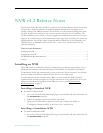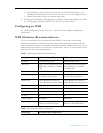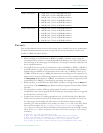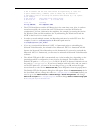
NVR v4.2 Release Notes
Network Video Recorder Release Notes 3
Caveats
This section addresses known issues in this release, most of which have an easy workaround.
For more information about any item, or help with an issue not listed here, contact your
reseller or VBrick Customer Service.
• When recording to an NVR from an MPEG-1/MPEG-2 encoder, and you stop the
recording before it reaches 1% of the Defined Record Duration, the FTP will fail with an
error message on the Status page. The NVR does not recognize extremely small files and
this is standard behavior.
• The NVR 40 lets you record any combination of up to 40 MPEG-1, MPEG-2, MPEG-4,
and WM streams at a time. There are however performance limitations when recording
multiple high-rate MPEG-2 or WM streams at the same time. At MPEG-2 rates up to
5.5MBps or WM rates up to 1.2MBps 40 simultaneous recordings are fully supported. At
higher rates however the full licensing capacity cannot be used. For example, when using
the
Best Quality WM template at 4.5MBps, 10 simultaneous records are supported; when
using MPEG-2 at 15MBps, 15 simultaneous recordings are supported.
• Batch recording to an NVR from a WM VBrick encoder is not supported; the
Batch tab
is greyed out on the
Scheduling page. Batch recording is supported from all other VBrick
encoders.
• The Portal Server and the NVR are tightly linked. In order to avoid backward
compatibility issues, always upgrade the NVR from the same package when you upgrade
the Portal Server, and vice versa.
• In some cases, because of a naming resolution issue, a LAN Network Video Recorder
(NVR) does not record when the ETV Portal Server server is in a DMZ. As shown on
the status page, the recording will either fail or run indefinitely (without actually
recording). To work around this issue, modify (or create) a
hosts file on the ETV Portal
Server as shown below. Go to c:\windows\system32\drivers\etc\hosts. Open the
hosts file in an editor and add the IP address and computer name of the NVR as shown
below. (If the
hosts file is not present, you must create one by saving a txt file with no
extension.)
# Copyright (c) 1993-1999 Microsoft Corp.
# This is a sample HOSTS file used by Microsoft TCP/IP for Windows.
# This file contains the mappings of IP addresses to host names. Each
# entry should be kept on an individual line. The IP address should
# be placed in the first column followed by the corresponding host name.
NVR – 10 Licenses • 73GB, SAS, 3.5-inch 10K RPM hard drive
• 73GB, SAS, 3.5-inch 10K RPM hard drive
• 146GB, SAS, 3.5-inch 10K RPM hard drive
• 146GB, SAS, 3.5-inch 10K RPM hard drive
• 146GB, SAS, 3.5-inch 10K RPM hard drive
• 146GB, SAS, 3.5-inch 10K RPM hard drive
NVR – 40 Licenses • 146GB, SAS, 3.5-inch 10K RPM hard drive
• 146GB, SAS, 3.5-inch 10K RPM hard drive
• 300GB, SAS, 3.5-inch 10K RPM hard drive
• 300GB, SAS, 3.5-inch 10K RPM hard drive
• 300GB, SAS, 3.5-inch 10K RPM hard drive
• 300GB, SAS, 3.5-inch 10K RPM hard drive










